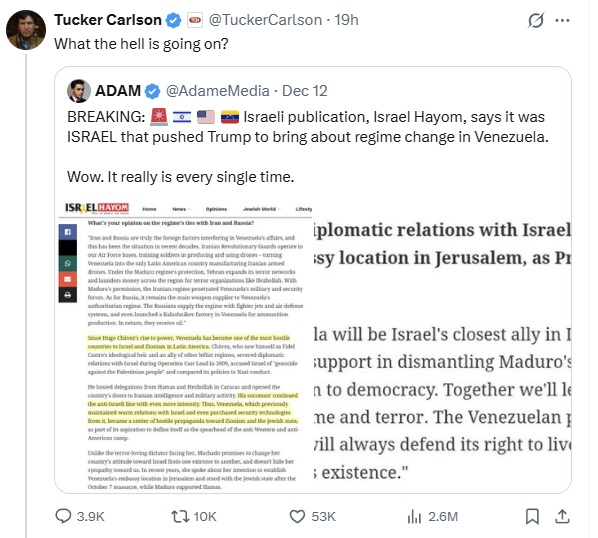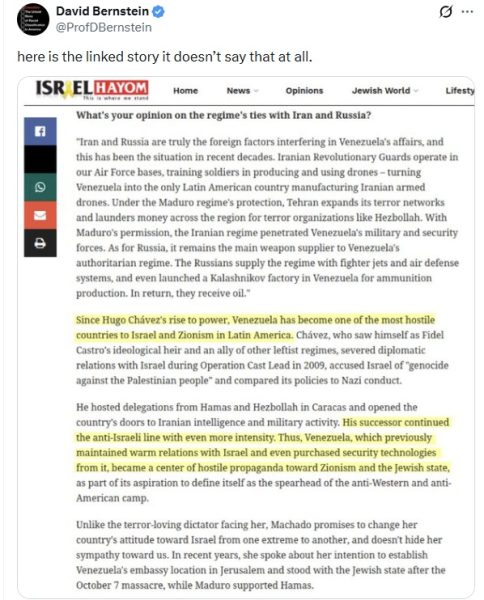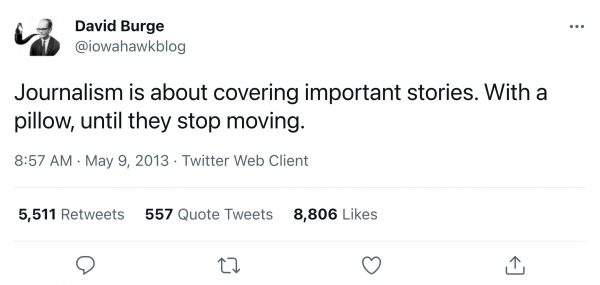TREAT YOUR SHOULDER PAIN: Shoulder-Heating-Pad-Heated-Wrap. #CommissionEarned
December 14, 2025
DECLINE IS A CHOICE: The Blue Zones Are 38% Ruined: but next week it’ll be 39%. “There’s a lot ruin in a blue zone. People in neighborhoods work at the preservation of order while they vote for disorder. Ordinary lives keep the squalor sort of more or less at bay, even when government stops bothering. Blue Model governance is a metastasizing disaster, caring for nothing and going broke while doing it. If you gave Gavin Newsom a dozen bright red roses, I suspect the bouquet would die in his hands before he could put it down. The man is the angel of death. But California isn’t dying; California is sort of okay, because many people sort of still try. The implication is that the decaying places could be turned around pretty easily, even after years of appalling government failure.”
Well, we saw that in NYC under Giuliani.
WELL, STAY TUNED:
🚨 BREAKING: In a rare development, the White House has lifted a “lid” and ordered reporters to return immediately.
This move comes amid growing reports that the President may deliver an “address to the nation.” pic.twitter.com/mUL5M1qhOA
— Digital Gal (@DigitalGalX) December 14, 2025
ROBERT SPENCER: Australia Discovers What It Means to ‘Globalize the Intifada.’
What exactly would it mean to “globalize the intifada”? What would a globalized intifada even look like? At least twelve people are dead and 29 injured on Australia’s Bondi Beach Sunday, as two Muslims opened fire upon a Hanukkah celebration. And so now the world has yet another example of what looks like when an intifada is globalized.
“Intifada” means “shaking off” or “rebellion,” and refers to armed struggle against Israel, including Israeli civilians. The Jerusalem Post noted back in 2021, when there was a good deal of globalization of the intifada that went largely unnoticed, that “during the Second Intifada from 2000-2005, Palestinian terrorist groups, including Hamas, Palestinian Islamic Jihad and some affiliated with Fatah, carried out hundreds of terrorist attacks against Israeli civilians and security personnel, killing more than 1,000.”
And so it is clear: globalizing the intifada means doing violence to Jews the world over. When New York City Mayor-elect Zohran Mamdani refuses to condemn the term, he is tacitly admitting that he has no problem with violence against Jews who are not members of the IDF, not fighting in Gaza, but just going about their business on Bondi Beach and elsewhere.
Australia welcomed in the killers who decided to globalize the intifada on Bondi Beach. It welcomed them as “asylum seekers” and “refugees,” but they were actually Islamic jihadis, or became Islamic jihadis once in Australia. (Either way, it’s not a good advertisement for Australia’s immigration policy, which is essentially the same as immigration policies all over Europe and North America.) One of the mass murderers is named Naveed Akram. He is from Pakistan. The other is Khaled al-Nabulsi, who hails from Lebanon and pledged allegiance to the Islamic State (ISIS). Police said that they were “aware” of one of these grateful asylum seekers before he made the decision to murder Jews in large numbers in order to gain the favor of Allah. They did not, obviously, do anything to stop him.
Related:
Many are trying to invert history
Claiming that Israel’s response to October 7th is why Jews around the world are being attacked
But this was Sydney 24 hours after October 7th
“Gas the Jews”
The West is playing with fire it doesn’t understandpic.twitter.com/GGU5nOwXNN
— Shaun Maguire (@shaunmmaguire) December 14, 2025
UPDATE:
🚨Bombs In Bondi: Police have now found multiple IED’s at the scene of the Muslim terror attack in Australia. pic.twitter.com/pqS8vJoTJD
— Don Keith (@RealDonKeith) December 14, 2025
DISPATCHES FROM THE MEMORY HOLE: Drive-By Shooting in Redlands, CA, Targets Hanukkah Display in Apparent Antisemitic Attack.
Don’t let the Australia shooting, Brown shooting, and foiled Germany ramming distract you from the California shooting. https://t.co/oc8A4FxjU6
— Max 📟 (@MaxNordau) December 14, 2025
TRUNALIMUNUMAPRZURE!
Does this have closed captions https://t.co/kZbgCqVu4q
— jimtreacher.substack.com (@jtLOL) December 14, 2025
DON’T THROW SHADE AT THIS DECISION: FDA considering allowing new sunscreen ingredient in U.S.
MEGAN MCARDLE: Why does anyone want to buy Warner Brothers, anyway?
Break out the popcorn and a jumbo box of Raisinets, because just when we thought the Warner Bros. Discovery drama was over, it turned out we had barely gotten started. The suspense over the company’s pending sale is mounting, and new questions are developing faster than writers can resolve old ones. Which suitor will shareholders choose? Will regulators block the deal? Will any of these characters find happily ever after?
If you remember last week’s episode, Netflix beat out Comcast and David Ellison’s Paramount Skydance to buy WBD — or at least its studio and streaming business, which are the bits everyone really wants. If you kept following the show, you’ve seen the action heat up: Ellison has launched a hostile bid for WBD, arguing that its shareholders would do better by taking $30 per share from him to buy the whole company, including its cable television stations — CNN, TNT, TBS and lifestyle outlets such as HGTV — than by getting $27.75 per share from Netflix for just the studio and streaming.
Spoiler alert: Cord-cutting is decimating the cable business so rapidly that this is a reasonable argument, even though the cable stations currently generate higher revenue and gross margins than streaming or studio. Between WBD’s debt and declining cable subscribers, there’s just not much future value left in those assets.
So stay tuned for more twists and turns! Eventually writers might resolve the biggest mystery: Why does anyone want to buy this company, anyway?
Fortunately, one august institution is dedicated to saving Warner Brothers from its ignoble fate: British cinemas demand Labour intervene against Netflix’s Hollywood takeover.
Cinemas have urged Labour to intervene in the planned takeover of Warner Bros by Netflix, warning that the deal would result in a “much thinner” selection of films for audiences.
Industry bosses have written to media minister Ian Murray to raise concerns about the streaming giant’s $83bn acquisition of the Hollywood studio behind major franchises such as Harry Potter, arguing that it could result in fewer films being released in cinemas.
In the letter sent to MPs on both the culture select committee and business and trade committee, Phil Clapp, the chief executive of the UK Cinema Association, said the takeover would be a “significant blow” to the industry – which is still struggling to recover from the pandemic.
Mr Clapp warned that audiences would be the biggest losers from the proposed deal, adding that it would also lead to significant job losses.
The trade group urged Mr Murray to take an active interest in the takeover and called on both committees to launch an inquiry.
Yes, launch an inquiry – write some really stern letters, England. That ought to do the job! But as John Podhoretz noted last week, we could be witnessing the “end of moviegoing” as we used to know it:
So the rap on Netflix buying Warners is this could be the end of moviegoing. That's wrong. Moviegoing is already over.
— John Podhoretz (@jpodhoretz) December 5, 2025
History will record that COVID killed the movie as we had understood it. The trend line of shrinking audience was already there, but the whole industry was ballasted in the 2010s by the blockbuster success of two kinds of films–animated movies and superhero movies.
— John Podhoretz (@jpodhoretz) December 5, 2025
And in a thread Twitter/X McArdle explained why she didn’t bother going into details in her Washington Post article about Ellison’s goal of acquiring CNN along with Warner Brothers, as aging viewers and declining numbers mean that technology is also reaching its twilight years as destination viewing:
My latest column is on the WBD merger drama, and why anyone wants to buy this company. My commenters are extremely mad that I focused on strategy and market economics rather than the specter of David Ellison controlling CNN. So here's why I didn't write about it.
— Megan McArdle (@asymmetricinfo) December 13, 2025
The CNN angle is getting so much play because media folks and political hobbyists who read a lot of news cannot imagine how little their hobby matters to the rest of the world. Also, like I said, they are old and to them 1995 is like yesterday. They can't quite believe it's over
— Megan McArdle (@asymmetricinfo) December 13, 2025
READER FAVORITE: BAMBOO COOL Men’s Ultra ComfortSoft Underwear. #CommissionEarned
WAIT, WHAT?: Woman goes in for surgery to remove a benign, 22-pound ovarian cyst. Doctors find a full-term baby boy too. Merry Christmas!
THE RISE OF GERMAN NATIONALISM EXPOSES WASHINGTON’S DELUSIONS:
The recent electoral surge of the right-wing Alternative for Germany (AfD) party, which secured 20.8 percent in February’s snap election and won state elections in Thuringia last year, has predictably triggered alarm bells throughout Washington’s foreign policy establishment. The usual suspects are warning of a new Nazi threat, the collapse of the transatlantic alliance, and the end of Western civilization as we know it. But beneath the hyperbole lies a more complex reality that American policymakers would be wise to understand rather than reflexively condemn.
Let’s be clear about what’s happening. The AfD’s rise is not some inexplicable resurgence of fascism but rather a predictable political backlash against decades of failed policies—economic stagnation in eastern Germany, botched immigration policies, and Berlin’s costly entanglement in the Ukraine conflict. When the mainstream parties offered voters more of the same, voters looked elsewhere.
Washington’s foreign policy blob has responded with its standard playbook: demonize, isolate, and lecture. Yet this approach fundamentally misunderstands both German politics and American interests. The same establishment that assured us NATO expansion posed no threat to Russia, that the Iraq War would be a cakewalk, and that Afghanistan could be turned into a democracy now wants us to believe that AfD supporters are crypto-Nazis rather than ordinary Germans fed up with bearing the costs of extreme liberalism and America’s geopolitical adventures.
Politico (whose parent company is based in Berlin) is getting the vapors that much of Europe is turning “hard right and far-right:”
If you actually look at the platforms of these “far right” parties, they’re like normie pre-Trump Republicans, except on migration (and generally pro welfare state). They’re not electing Nazis; they’re electing Bob Dole. https://t.co/cnCreNshl7
— Rod Dreher (@roddreher) December 13, 2025
But then, the left see “far right” as being everywhere these days:
When far left legacy media refers to the “far right”, they actually mean centrists https://t.co/qzkI9g5jz2
— Elon Musk (@elonmusk) December 6, 2025
If only there was a way to slow the rise of the “far right” in both Europe and America:
— Elon Musk (@elonmusk) December 13, 2025
HMM: Person of interest taken into custody in Brown University shooting, officials say. Zero details, however.
UPDATE: They know more than they’re telling. And I think I know why they’re not telling. I think you do too.
Crazy https://t.co/nicjsWcsdF
— The Questionable Gardner (@T_Q_Gardner) December 14, 2025
UPDATE (From Ed):
Brown University. https://t.co/FfRl2zvJvK
— Stephen L. Miller (@redsteeze) December 14, 2025
FUN GIFT: LEGO Ideas Tuxedo Cat – Building Sets for Adults. #ComissionEarned
AUSTRALIA’S BONDI BEACH SHOOTING: What we know so far about Hanukkah attack.
Twelve people have died — including one gunman — following a shooting at Australia’s Bondi Beach which targeted the Jewish community on the first day of Hanukkah.
According to police, 29 others were taken to hospital and two officers were shot during the incident, which has since been declared a terror attack by officials. The surviving gunman is in a critical condition.
More than 1,000 people were attending an event on the beach celebrating Hanukkah.
Chris Minns, the premier of New South Wales, said: “Our heart bleeds for Australia’s Jewish community tonight.
“I can only imagine the pain that they’re feeling right now to see their loved ones killed as they celebrate this ancient holiday”.
Its origin and purpose, still a total mystery:
One of the suspected gunmen of the Bondi Beach massacre shooting in Australia has been identified as Naveed Akram. He was injured. At least 11 people were killed. The shooting happened as a family “Chanukah by the Sea” event was taking place. https://t.co/XPaat3aOaD pic.twitter.com/swhboMX805
— Andy Ngo (@MrAndyNgo) December 14, 2025
UPDATE: From last December: How Australia went from ‘goldene medina’ to ‘vitriol and vilification’ of Jews.
WELL, THIS IS THE 21st CENTURY, YOU KNOW: Orbital Data Centers Will “Bypass Earth-Based” Constraints.
Last week, readers were briefed on the emerging theme of data centers in low Earth orbit, a concept now openly discussed by Elon Musk, Jensen Huang, Jeff Bezos, and Sam Altman, as energy availability and infrastructure constraints on land increasingly emerge as major bottlenecks to data center buildouts through the end of this decade and well into the 2030s.
Nvidia-backed startup Starcloud has released a white paper outlining a case for operating a constellation of artificial intelligence data centers in space as a practical solution to Earth’s looming power crunch, cooling woes, and permitting land constraints.
Terrestrial data center projects will reach capacity limits as AI workloads scale to multi-gigawatt levels, while electricity demand and grid bottlenecks worsen over the next several years. Orbital data centers aim to bypass these constraints by using near-continuous, high-intensity solar power, passive radiative cooling to deep space, and modular designs that scale quickly, launched into orbit via SpaceX rockets.
“Orbital data centers can leverage lower cooling costs using passive radiative cooling in space to directly achieve low coolant temperatures. Perhaps most importantly, they can be scaled almost indefinitely without the physical or permitting constraints faced on Earth, using modularity to deploy them rapidly,” Starcloud wrote in the report.
Starcloud continued, “With new, reusable, cost-effective heavy-lift launch vehicles set to enter service, combined with the proliferation of in-orbit networking, the timing for this opportunity is ideal.”
No word yet how SID is holding up these days.
STARVE ALL YOU WANT, KIDS; Hunger-striking UC Berkeley lecturer suspended for anti-Israel politicking in class: Leftist students conduct own hunger strike in solidarity: ‘Bring your keffiyeh, flag, signs & friends!’
Or swastikas. Same difference.
CARLSON GOES FULL CANDACE OWENS: Appealing to low-IQ credulous conspiracy theorists is a sure way to destroy a political movement, and Tucker seems to be giving it the old college try. Here’s the background: The communist anti-American government in Venezuela naturally hates Israel, while the opposition leadership is friendly. This is hardly a secret. The Israeli newspaper Israel Hayom has a story about this. A nutty anti-Israel leftist posted an excerpt from the story, with the caption, “Israeli publication, Israel Hayom, says it was ISRAEL that pushed Trump to bring about regime change in Venezuela.” Except that the story does not say anything remotely like that. Which didn’t stop Tucker from going into his “just asking questions mode,” to provide more oxygen for this non-story.


STAY STRONG FOR THE HOLIDAYS: Toniiq NAD+ Supplement 1500mg. #CommissionEarned
YEP.
So. Best the Democrats and their flying media monkeys could do from the latest tranche of "Epstein files" is an image of adult women from a beauty contest in Hawaii with their faces blacked out by deceptive editing 31 years after the fact.
I'm not Trump's biggest fan, but crap…
— Eric S. Raymond (@esrtweet) December 13, 2025
NOTHING’S TOO LOW FOR THEM IF IT CAN BE SPUN AS #RESISTANCE: From Defending Rape to Excusing 9/11: 10 Statements That Define Mainstream Media Darling Hasan Piker: Glowing media profiles of Hasan Piker shield their readers from what he truly believes.
Evergreen:


21ST CENTURY MEDICAL EDUCATION ISN’T WHAT I WAS HOPING FOR: Drexel med school module makes ‘antiracism’ and CRT part of doctors’ ethical duty.
BE CAREFUL WHAT YOU ASK AND HOW: There are gotcha questions, silly questions, rhetorical questions and pointed questions. That’s just for starters. Michael Foster, an Ohio pastor handed a Sunday bullhorn by Rod Martin, uses that momentous question posed by Satan to Eve to launch an incisive analysis of the modern weaponization of the question.

